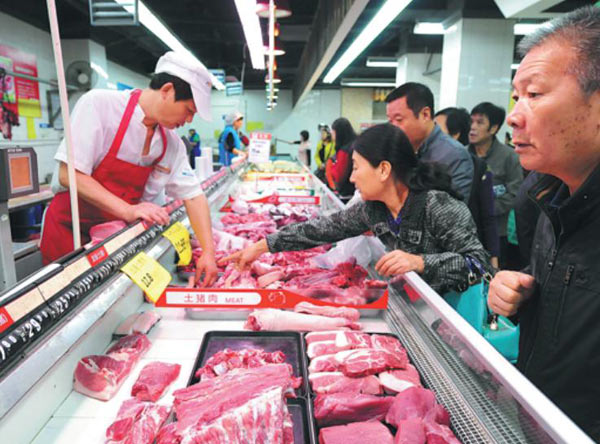US, Canada vie to satisfy China's voracious appetite for pork
 |
|
Chinese customers purchase pork at a supermarket in Jiujiang, Jiangxi province. [Photo by Hu Guolin/For China Daily] |
BEIJING — Canada has overtaken the United States as the top North American supplier of pork to China as farmers and meat packers in both nations battle for lucrative shares of the biggest global market.
Canada's pork sales to China, after a sharp rise last year, exceeded those of the US in the first quarter of 2017.
That's only happened a handful of times in two decades, according to US and Canadian government data.
Rising affluence is driving China's voracious appetite for pork, including parts of the pig-feet, elbows, innards-which command little value in most countries.
Nevertheless, it doesn't mean the productivity of farms in China has been reduced.
According to the data of the Food and Agriculture Organization, China, which is both the leading producer and the largest consumer of pork, rising pork consumption has led the sellers to take up the slack in supply by importing.
In fact, the imported pork products are not as popular as the imported beef in China. Some consumers have even never heard of imported pork.
"The fresh pork is local production, we don't have any imported pork supply," said Ito Yokado Beijing store official who is in charge of the store's fresh pork supply.
Beijing Central Key Trading Co Ltd, a Beijing-based food importer, said that the competitive price of imported pork was the major reason for it to do the business. The imported meat must be frozen during the transportation as a precondition, therefore the price is much lower than the fresh meat.
Drug-free exports
Canadian farmers have almost completely removed the growth drug ractopamine from their pigs' diet, largely because it is banned in China, which consumes half the world's pork.
In contrast, the US exports to China are limited because only about half of the nation's herd has been weaned off the drug, according to US hog producers, meat packers and animal feed dealers.
But major US-based firms are now moving to produce more ractopamine-free hogs-including the three biggest pork producers, Smithfield Foods, Seaboard Foods, a division of Seaboard Corp, and Triumph Foods, a hog farmer cooperative.
The rise of Canada's pork exports underscores the power of the gargantuan Chinese market to influence agricultural practices and profits in supplier countries worldwide.
As recently as 2013, annual US pork sales to China, some 333,000 metric tons, more than doubled Canada's shipments of 161,000 tons.
That's the same year Canada's hog industry started to remove ractopamine, best known as Eli Lilly & Co product Paylean.
In the first quarter of this year, Canada shipped nearly 93,000 tons of pork to China, on pace to hit 372,000 tons annually. That eclipsed the 87,500 tons that the US shipped, according to data from both governments.
The European Union, which has long banned ractopamine, is among China's top foreign pork suppliers, exporting 393,365 tons in the first quarter.
Chinese authorities banned the use of ractopamine in livestock in 2002. They say meat raised with the drug can cause nausea and diarrhea in people and be life-threatening to sufferers of heart disease.
US stance odd
The US Food and Drug Administration, however, did not see the same dangers when it approved ractopamine in 1999, concluding that it would "not have a significant impact on the human environment".
The FDA's stance has drawn some criticism, including a 2014 lawsuit by environmental groups alleging the agency has not fully examined the drug's impact. The suit was later dismissed on technical grounds but is being appealed.
Hog farmer and rancher groups defend ractopamine use, saying it allows them to grow livestock more efficiently, with less feed, said Dave Warner, spokesman for the National Pork Producers Council. Canadian health authorities also allow consumption of pork from hogs raised with the drug.
The China market is so lucrative that Canada's HyLife started selling pork online directly to Chinese consumers last year.
The small Manitoba processor hawks pig feet and elbows on e-commerce site JD.com, a competitor of Alibaba Group Holding Ltd.
"They're big online buyers," said Claude Vielfaure, HyLife's chief operating officer. "You try to move your pork all kinds of ways."
Costly by-products
Rising Chinese pork demand has driven up prices for by-products including pigs' feet, kidneys and livers.
Pigs feet sell for more than $1.85 per kilogram-about double their value two years ago, said Richard Davies, executive vice-president of sales and marketing at Olymel, one of Canada's biggest pork packers.
Selling by-products can squeeze another $10 per pig from a carcass that otherwise earns packers about $180, said Ray Price, president of Alberta-based processor Sunterra Meats.
Stewed pigs' feet with white beans is a famous dish from Sichuan province, one of China's culinary capitals, while blood sausage, made from intestines and cooked with pickled vegetables, is a traditional winter dish in the Northeast.
Chinese consumers enjoy the strong flavor of offal-internal organs and entrails. In Beijing, stir-fried pig's liver with vegetables is common on dinner tables and known for its nutritional value.
In all, China consumed 55 million tons of pork last year. Although that is the lowest total in four years, imports are rising fast because millions of China's small-scale farmers have left the pork business in recent years because of falling prices.
In fact, it did not lead to shortage of pork at the consumer level. The huge domestic demand of pork ensured pork was imported.
Chinese dietary structure is such that many dishes are made from pork. It is certain that the market demand for pork is much more than that for beef and mutton, according to Beijing Central Key Trading Co Ltd.
China key to trade
China became Quebec-based Olymel's biggest export market last year, vaulting over the US and Japan. It plans to open a sales office in China as early as next year.
"Just a tweak in that market can change the game for anyone in the world," Davies said.
US pork producers have moved more slowly than their Canadian competitors to raise ractopamine-free pigs, primarily because the US is the world's third-biggest domestic market for pork.
Precisely because of that reason, Beijing Central Key cut its imports from the US, the company said. It also made it clear that any import of the pork containing this drug is not its priority.
Tyson Foods Inc and Hormel Foods Corp continue to process hogs that were fed ractopamine in part because they do not raise their own pigs.
Hormel's hog supply "comes from more than 500 family farms", the company spokesman said, many of which use the growth drug.
US firms can also send pork from ractopamine-fed hogs to Mexico and Japan, the top US pork export markets.
But many US-based suppliers are nonetheless scrambling to take advantage of Chinese demand for ractopamine-free pork.
Smithfield, the world's biggest pork producer and a subsidiary of Hong Kong-listed WH Group, has raised most of its hogs without the drug for more than two years, a spokeswoman said.
As the top exporter of pork to China, Smithfield firm shipped 300,000 tons there from the US and Europe last year.
The second-and third-biggest US pork producers-Seaboard and Triumph-are jointly opening a pork processing plant in July in Sioux City, Iowa, where nearly all hogs slaughtered will be ractopamine-free, according to local hog producers and animal feed mills.
Building dedicated ractopamine-free pork plants allows processors to limit risk of China rejecting shipments that contain trace amounts of the drug.
Seaboard declined to comment about ractopamine. Triumph did not respond to requests for comment.
The Cooperative Farmers Elevator in Ocheydan, Iowa, is constructing a new feed mill that by 2018 will produce only ractopamine-free animal feed.
"It was requested from some of the customers we deal with," said Steve Peterson, the cooperative's vice-president of feed. "The one that is pushing the hardest is Seaboard."
US hog producer Prestage Farms also is planning a new Iowa slaughterhouse for as many as 10,000 ractopamine-free hogs annually by 2018, said Ron Prestage, its president.
With the US hogs in record supply, foreign demand is essential to profits, Prestage said.
"When we have plentiful hogs, as we do today, packers prefer not to have ractopamine," Prestage said. "They want to be able to export as much product as they can."
Agencies- China Daily




















